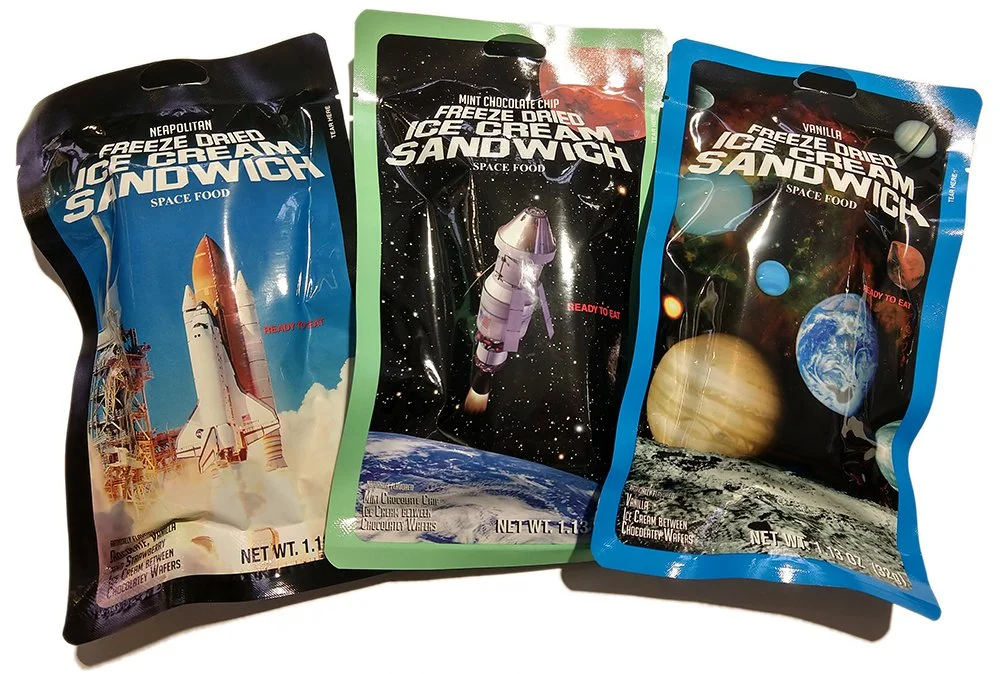A Meal with a View: Space Food
Corinne Moore, Technical Business Development Associate
4 minute read
Oh, the conversation as old as time, “Honey, what do you want for dinner?” “I don’t know, whatever you want.” Rinse and repeat until we end up with a bowl of cereal for dinner. Food is a huge part of our lives and that is by no means limited to those of us on earth. Astronauts of today spend upwards of six months in space, and that adds up to a lot of meals! There are scientists who dedicate their careers to making meals nutritionally dense specifically for our astronauts, but that’s not all that goes into it. The factors that make a meal delicious go beyond nutritional value of course and must take into account flavor, texture, temperature, and color. Being able to enjoy one’s food also has a great impact on mental health, which must be considered in the overall picture of astronaut health and quality of life. With all of this in mind, grab a spork, your favorite lunch, and let’s talk about space food!
When it comes to space food, the first thing you might think of is astronaut ice cream. Contrary to popular belief, this freeze dried treat was not originally space food due to its crumbly nature. Any food that produces significant crumbs is a no go, as tiny particles floating around could damage valuable on-board equipment by getting stuck in circuits, moving parts, etc. Another food synonymous with space exploration is Tang, which was not invented by NASA, but available commercially before it was introduced as a solution for drink transport in-orbit. Buzz Aldrin joked that he was not a fan of the famous orange drink.
The menu for the first human to orbit the Earth was anything but gourmet. In 1961, cosmonaut Yuri Gargarin was given squeezable tubes of pureed meat and a tube of chocolate sauce for dessert. The following year the United States sent John Glenn on his own orbit, this time adding in an applesauce tube and sugar tablets to mix with water. Needless to say, the astronauts were not particularly pleased about the food and made their complaints known. So much so that, during the Gemini 3 mission, Gus Grissom and John Young got themselves into hot water when they snuck a corned beef sandwich onboard and shared it mid-flight. You know the provided food has to be bad if you’re willing to risk the ire of your commander, country, and Congress! Fortunately, today’s astronauts aboard the ISS have hot water and a modest galley where they can prepare meals that are far more appetizing. Tortillas are a fan favorite and approved for flight due to their stable shelf life and limited crumble capacity.
You might think, given how long humans have maintained a presence in space aboard the ISS, that space food development has ended. As with most areas of aerospace, instead the development is ever-advancing. Scientists are still diligently working on new space foods for the ISS and looking for shelf-stable options that could work for much longer trips. In 2019, astronauts Luca Parmitano and Christina Koch carried out an experiment baking cookies in space using a special oven. Sadly, the crew wasn’t allowed to try the treats, which were packed up and sent back to Earth to verify if the cookies were safe for consumption.
Not only what we eat, but how we eat also factors into the enjoyment of a meal. Sipping morning coffee out of a styrofoam cup is far less enjoyable than from a favorite mug (of which I have entirely too many, it’s a problem). Turns out, our astronauts felt the same way. In 2008, Don Pettit decided he had enough of drinking hot coffee from a straw and got creative. Using plastic from a Flight Data File book, he created his own coffee mug that also prevented spills in microgravity. Less than a decade later, the ISSpresso machine made its debut in 2015 with Samantha Cristoforetti’s trial run, which allowed astronauts to enjoy in-orbit espresso for a couple of years (the machine has since been retired). All of this to say, it’s the little quality of life improvements that can make a stay aboard the ISS feel a little more like home.
Outside of prepackaged foods, ongoing research aboard the ISS has resulted in many successful harvests of plants, including radishes, red romaine lettuce, wheat, kale, and bok choy. It was even found that some of these plants, like wheat, grow taller in the microgravity environment. Experiments such as these lay the groundwork for keeping astronauts fed on long duration missions, especially the trip to Mars, which takes about 9 months one-way. Of course, growing enough food to sustain our Martian travelers will present unique logistical and financial challenges. Agriculture supplies are heavy and thus expensive, as the price to send items to space is calculated on a dollar amount per kilogram. To send a payload of supplies one way to the ISS alone will set you back $20,000 per kg so you’re not going to want to have to do that very often. To successfully maintain a food-generative ecosystem in-orbit and on other planets will require repurposing waste in creative ways to keep the harvest output at sustainable levels. KMI applies this mindset to our mission to not only remove space debris, but repurpose the scrap for in-space servicing and recycling. Much like our farmers of the future, we’ll use waste to keep space technology running past its initial lifespan.
Now that you’ve reached the end of this column, are you as hungry as I am? Next time you have a hankering for a midnight snack, think about our space travelers and enjoy an extra crumbly cookie just for them, preferably over the sink so you don’t make a mess!
Recommended column to read next: Water Bears IN SPACE and Euclid: Mission and Importance





